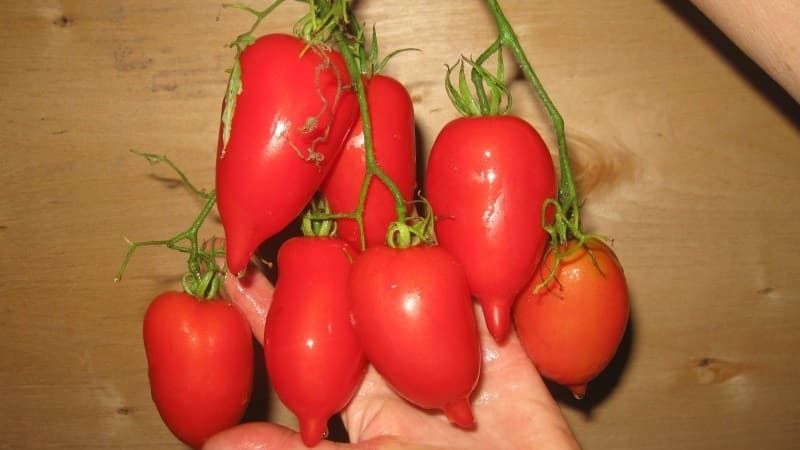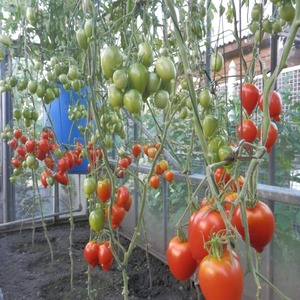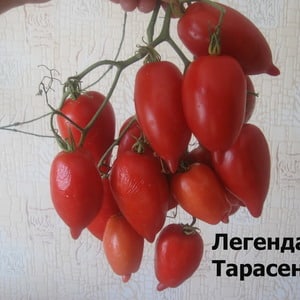A young variety that is gaining popularity among summer residents is the “Legend Tarasenko” tomato, ideal for growing in open ground.
Vegetable growers create legends about the productivity of tomatoes from the Ukrainian breeder Tarasenko. They captivate even summer residents with considerable experience with their unprecedented fruiting rates. Tomato Legend Tarasenko is one of these legends.
In addition to the excellent taste and unusual shape of ripe vegetables, the crop pleases with a rich harvest in any weather. This species is recognized as the best of all the developments of the amateur breeder.
Characteristics and description of the variety
Feodosius Makarovich Tarasenko is a physics teacher at school, an amateur gardener, and the creator of more than 50 types of tomato crops. One of its earliest and best varieties is Legend Tarasenko (Multiflora), intended for cultivation in open ground.
Distinctive features
Bush indeterminate, up to 2 m high, 5-7 fruiting clusters are formed on the stem. The cluster is complex, each bears 20-25 fruits.
The ripening period is average, from the moment of emergence of seedlings to full ripening, 115-120 days pass. It is recommended for cultivation in open ground, but in regions with short summers it is planted in a greenhouse. Fruiting is extended, until frost.
The productivity is high, up to 20 kg of vegetables are harvested from 1 bush, provided that 3 seedlings are planted per 1 sq. m. m.
Resistance to diseases is high, immune to most dangerous diseases.
The crop requires regular pinching and staking of tall bushes, otherwise the heavy fruit-bearing branches will spread along the ground.
Fruit characteristics
Average weight - 85-110 g, cylindrical shape in the form of an elongated cream, bright scarlet color. The taste is pleasant, sweet, without sourness, the flesh is juicy and meaty. The skin is dense and does not crack.
The purpose in cooking is universal; it is used fresh, for preparations for the winter and for processing into tomato products.
Ripe vegetables are stored for a long time and can withstand long-term transportation, maintaining their marketable appearance.
The photo shows Legend Tarasenko tomatoes.

How to grow seedlings
Preparing seeds for sowing begins 2 months before planting seedlings in the ground. Late February-early March.
Seed preparation
 First, the seeds are immersed in a saline solution for 10 minutes. This is how they check the empty ones: those that float up are not suitable for landing.
First, the seeds are immersed in a saline solution for 10 minutes. This is how they check the empty ones: those that float up are not suitable for landing.
Disinfect planting material by immersing it in a weak solution of potassium permanganate for 20 minutes. Afterwards, the grains are washed with running water and dried.
Heat treatment for 25 minutes makes the seeds stronger and more elastic, which will help in their germination: the seeds are heated in hot water at a temperature of 52 degrees, having previously wrapped them in gauze. Immediately after this, rinse in cold water for 2 minutes.
During heat treatment, about 30% of seeds may lose their viability. But this is not scary: only non-viable specimens die.
To improve germination, seed material is placed in a growth stimulator for 12 hours. As soon as the seeds swell slightly, they can be sown in the ground.
Container and soil
The soil is prepared from garden soil and humus in equal quantities. For looseness, add a little sawdust or peat - the soil becomes airy and allows moisture to pass through well.
The prepared mixture is laid out halfway in the planting containers, so that later, as the seedlings grow, the remaining soil can be added to the containers. This technique helps to obtain nutrients in the required quantities.
You can plant in a common wooden box and disposable containers, for example, in plastic or peat cups.
Reference! While the sprouts are in peat cups, the young roots are generously supplied with oxygen, since the material is porous and allows oxygen to pass through well.
Sowing
The seeds are sown in prepared containers to a depth of 1.5-2 cm. Sprinkle peat on top and lightly moisten with a spray bottle. Then the containers are covered with film to create a greenhouse effect.
Reference! If the planting material is sown shallowly, it will germinate along with the shell, which will cause further slow growth.
The sown containers are left in a bright and warm room at a temperature of at least 24 C. If the temperature is maintained at a constant temperature, the first shoots can be seen after 7 days.
Growing and caring for seedlings
After the first shoots appear, the film is removed and the containers are moved to a sunny windowsill.
Reference! To avoid serious burns, seedlings should not be exposed to direct sunlight.
 There should be at least 14 hours of daylight. If there is a lack of natural light, add phytolamps.
There should be at least 14 hours of daylight. If there is a lack of natural light, add phytolamps.
After all seeds have germinated, the temperature in the room where the seedlings are located is reduced to 15 C for 1 week. This is how the young bushes are hardened and the immune system is strengthened. After 7 days, the seedlings are transferred to a warmer place with an air temperature of at least 20 C.
Water with warm, settled water as the top layer of soil dries out. Water with a shallow watering can or tablespoon along the edge of the containers, without flooding the soil, otherwise the young roots may rot.
After 2-3 true leaves appear, the seedlings are planted, planted in separate containers. When growing in peat cups, seedlings do not need to be picked.
2 weeks before planting in the ground, the seedlings are hardened off. To do this, it is taken out into the open air for 1 hour, gradually increasing the time spent on the street to 13 hours. The night temperature of the room where the seedlings are brought is reduced to 12 C.
How to grow tomatoes
After 2 months, the seedlings are ready for transplanting into the ground. By this time, the root system is sufficiently developed and penetrates deep into the soil. In addition, the bushes are fully formed and have one ovary.
Landing
Seedlings are planted in the ground in late May-early June, when the ground warms up to 15 C. The soil for tomatoes is prepared a month before planting, it is dug up and weeds with roots are removed. Due to the developed roots, the holes are made at least 35 cm deep, adding a little humus, wood ash and mineral fertilizer to the bottom.
Planting pattern: 80 cm – distance between seedlings, 90-110 cm – between rows. 2-3 seedlings are placed in one hole so that the plants stick to each other. Spray with a weak solution of potassium permanganate.
Reference! It is best to replant on a cloudy day or in the evening. This method promotes faster adaptation of seedlings to street conditions.
After transplanting, the tomatoes are watered abundantly and left for 10-12 days for them to take root in the ground on their own.
Further care for Legend Tarasenko
Regular watering set once a week. Water generously, at the root, with at least 7 liters of warm, settled water per bush until the fruit begins to form. Despite the large amount of moisture consumed, the beds should not be allowed to become waterlogged. This can lead to the development of fungal diseases. Also, increased humidity can affect the taste of vegetables.
Reference! Water in the morning or evening to avoid burning the green mass if moisture gets on the leaves.
 After each watering, loosening is carried out, removing weeds with roots. This not only improves the penetration of oxygen into the soil, but also serves as a necessary preventive measure in pest control. To retain moisture in the beds, they are mulched with straw or weeds. When weeds rot, they release beneficial substances, thereby feeding the roots of the plants.
After each watering, loosening is carried out, removing weeds with roots. This not only improves the penetration of oxygen into the soil, but also serves as a necessary preventive measure in pest control. To retain moisture in the beds, they are mulched with straw or weeds. When weeds rot, they release beneficial substances, thereby feeding the roots of the plants.
Feed for the first time after 14 days after transplant into the ground a full complex of mineral fertilizers or organic matter. As organic matter, mullein infusion or bird droppings are used in a ratio of 1:15.
The second time is fed during the formation of the ovaries. The second feeding is no different from the first; organic matter or mineral fertilizers are used.
Third feeding - during fruiting. Potassium fertilizers are added to the mineral solution - they contribute to the rapid filling of fruits.
Features of cultivation and possible difficulties
Due to their high growth and heavy load on the stem, tall plants require mandatory staking. tied up not only the stem, but also the fruit-bearing branches, since they cannot withstand the weight of ripe vegetables and bend to the ground.
Constant contact with wet beds leads to rotting of the fruits. For fixation, a metal or wooden support is installed next to each bush.
Stepsons regularly by removing unnecessary shoots. It is recommended to leave 2-3 cm so that new stepsons do not grow from the shoot.
For maximum yield, the crop is formed into 1 or 2 stems. It is under this condition that the greatest return is possible.
Diseases and pests
 The culture is resistant to many diseases, but neighboring plants can infect it. You should not plant crops belonging to the nightshade family next to tomatoes.
The culture is resistant to many diseases, but neighboring plants can infect it. You should not plant crops belonging to the nightshade family next to tomatoes.
Among the infections, the following are especially distinguished: tobacco mosaic, brown spot and gray rot. Tobacco mosaic has a viral etiology and is characterized by white stains on a discolored leaf, to which yellow spots are then added. It is possible to cure the plant only in the first stages by replacing the top layer of soil and treating it with a milk solution (1 liter of milk per 10 liters of boiled water) with the addition of a few drops of iodine. Be sure to treat with any fungicide.
Brown spot and gray mold are fungal diseases. Their prevention is moderate watering and regular loosening. Fungal spores develop at high humidity and high temperatures, so it is necessary to monitor the condition of the beds. Antifungal insecticides such as Fitosporin and Bordeaux mixture help in the fight against these diseases.
Reference! The use of chemicals is possible only before the formation of the ovaries.
Dangerous pests include the mole cricket, Colorado potato beetle, whitefly and aphid. For whiteflies and aphids, use soap solutions with the addition of ash.The Colorado potato beetle is collected by hand, and the mole cricket is scared away from the beds by planting sharp-smelling plants next to the tomatoes.
Preventive measures are the most effective in the fight against pests. Find the insect in time and stop its reproduction. Daily inspection of plantings is necessary.
The nuances of breeding in open ground and in a greenhouse
Greenhouse plants grow up to 2.5 m in height, so they are pinched to limit their growth point.
Although the variety is recommended for open ground in cold regions, it is also successfully grown in closed structures. Productivity and taste do not become worse because of this. Greenhouses must be regularly ventilated to avoid the spread of fungal spores.
In warm regions, the tomato is formed into 1 stem, in cold areas - into 2 stems.
In order not to overload the bush, the lower leaves of the plants are removed down to the third pair from the bottom.
Harvesting and application
Fruit ripening is uniform, fan clusters ripen entirely, which does not make it difficult to collect ripe vegetables. Fruiting is extended, in greenhouses the fruits ripen until the first frost.
The purpose of ripe vegetables is universal: They are eaten fresh and perfectly complement hot and vegetable dishes, such as stews and mashed potatoes. Small fruits are used for whole-fruit canning, larger vegetables are used for pickling and marinades. Also used for making juice, lecho, ketchup and adjika.
Ripe vegetables can be stored for a long time and can withstand long-term transportation.
Advantages and disadvantages of the variety
The legend Tarasenko has a lot of positive qualities:
 ease of care;
ease of care;- excellent yield;
- resistance to diseases of the nightshade family;
- adaptation to climatic conditions;
- survival rate in all regions;
- excellent taste of fruits;
- unusual shape;
- versatility in cooking;
- excellent presentation;
- long-term storage;
- long transportations.
The only negative properties include the need to tie up tall bushes and systematically plant the crop.
Farmer reviews
The legendary tomato, created by a Ukrainian amateur breeder, has many fans. Here are the opinions of some gardeners:
Olga, Brest: “The clusters contain a large number of fruits, suitable for both canned food and salads. The taste is excellent, sweet, slightly sour. I grow it in a greenhouse, the stem is powerful, but I can’t do without a garter.”
Tamara, Astrakhan region: “I grow the plant in 2 trunks, I have been planting this species for more than 3 years. The vegetables are delicious, just what I need. There is always enough to eat in the summer and to prepare for the winter. I recommend it to everyone."
Conclusion
The Legend Tarasenko tomato is famous for its high fruiting rates, ease of care and resistance to most diseases of the nightshade family. A school physics teacher immortalized his name in the name of a tomato crop.
The fact that tomatoes have been grown in garden plots since the mid-80s speaks of quality that has been tested over the years. In all regions, in any weather, this high-yielding variety will delight every gardener with excellent tomatoes.